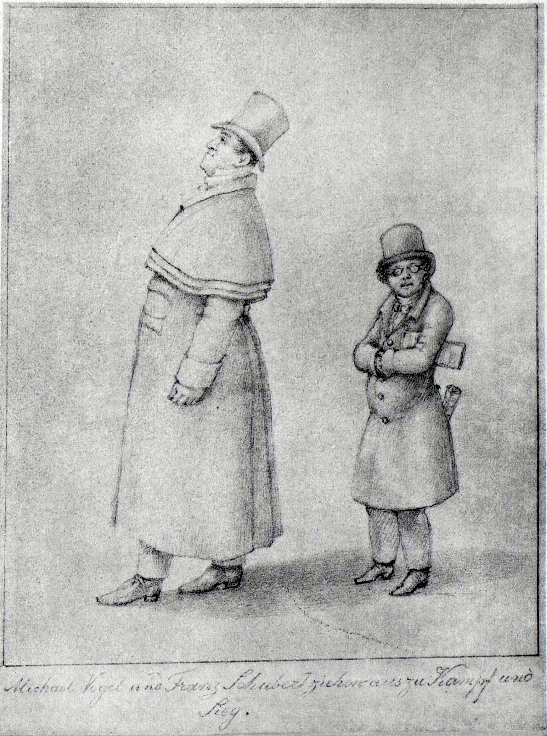|
Forellenquintett
The ''Trout Quintet'' (''Forellenquintett'') is the popular name for the Piano Quintet in A major, D. 667, by Franz Schubert. The piano quintet was composed in 1819, when he was 22 years old; it was not published, however, until 1829, a year after his death. Rather than the usual piano quintet ensemble of piano and string quartet, the ''Trout Quintet'' is written for piano, violin, viola, cello and double bass. According to Schubert's friend Albert Stadler, it was modelled on an arrangement of Johann Nepomuk Hummel's then-popular Septet in D Minor for Flute, Oboe, Horn, Viola, Cello, Bass and Piano, Op. 74. That arrangement, using the same, somewhat unusual instrumentation chosen by Schubert, had been published in Vienna in about 1817, only a few years before the composition of the ''Trout Quintet''. It may also have been influenced by Hummel's Quintet in E flat minor, Op. 87 . Nickname The piece is known as the ''Trout'' because the fourth movement is a set of variations o ... [...More Info...] [...Related Items...] OR: [Wikipedia] [Google] [Baidu] |
Franz Schubert
Franz Peter Schubert (; ; 31 January 179719 November 1828) was an Austrian composer of the late Classical period (music), Classical and early Romantic music, Romantic eras. Despite his short life, Schubert left behind a List of compositions by Franz Schubert, vast ''oeuvre'', including more than 600 ''Lieder'' (art songs in German) and other vocal works, seven complete symphonies, sacred music, operas, incidental music, and a large body of piano and chamber music. His major works include "Erlkönig (Schubert), Erlkönig", "Gretchen am Spinnrade", and "Ave Maria (Schubert), Ave Maria"; the Trout Quintet, ''Trout'' Quintet; the Symphony No. 8 (Schubert), Symphony No. 8 in B minor (''Unfinished''); the Symphony No. 9 (Schubert), Symphony No. 9 in C major (''Great''); the String Quartet No. 14 (Schubert), String Quartet No. 14 in D minor (''Death and the Maiden''); the String Quintet (Schubert), String Quintet in C major; the Impromptus (Schubert), Impromptus for solo piano; the S ... [...More Info...] [...Related Items...] OR: [Wikipedia] [Google] [Baidu] |
Wanderer Fantasy
The Fantasie in C major, Op. 15 ( D. 760), popularly known as the ''Wanderer Fantasy'', is a four-movement fantasy for solo piano composed by Franz Schubert in 1822. It is widely considered Schubert's most technically demanding composition for the piano. Schubert himself said "the devil may play it," in reference to his own inability to do so properly. Historical background Schubert composed this work in late 1822, just after breaking off work on the Unfinished Symphony while sketching its incomplete scherzo. It was written for and dedicated to Carl Emanuel Liebenberg von Zsittin, who had studied piano with Johann Nepomuk Hummel, in the hope of some remuneration from the dedication. It is not only a technically formidable challenge for the performer, but also a structurally formidable four-movement work combining theme-and-variations with sonata form. Each movement transitions into the next instead of ending with a final definitive cadence, and each starts with a variation of ... [...More Info...] [...Related Items...] OR: [Wikipedia] [Google] [Baidu] |
Accompaniment
Accompaniment is the musical part which provides the rhythmic and/or harmonic support for the melody or main themes of a song or instrumental piece. There are many different styles and types of accompaniment in different genres and styles of music. In homophonic music, the main accompaniment approach used in popular music, a clear vocal melody is supported by subordinate chords. In popular music and traditional music, the accompaniment parts typically provide the "beat" for the music and outline the chord progression of the song or instrumental piece. The accompaniment for a vocal melody or instrumental solo can be played by a single musician playing an instrument such as piano, pipe organ, or guitar. While any instrument can in theory be used as an accompaniment instrument, keyboard and guitar-family instruments tend to be used if there is only a single instrument, as these instruments can play chords and basslines simultaneously (chords and a bassline are easier to play sim ... [...More Info...] [...Related Items...] OR: [Wikipedia] [Google] [Baidu] |
Sextuplet (music)
In music, a tuplet (also irrational rhythm or groupings, artificial division or groupings, abnormal divisions, irregular rhythm, gruppetto, extra-metric groupings, or, rarely, contrametric rhythm) is "any rhythm that involves dividing the beat into a different number of equal subdivisions from that usually permitted by the time-signature (e.g., triplets, duplets, etc.)" This is indicated by a number, or sometimes two indicating the fraction involved. The notes involved are also often grouped with a bracket or (in older notation) a slur. The most common type of tuplet is the triplet. Terminology The modern term 'tuplet' comes from a rebracketing of compound words like quintu(s)-(u)plet and sextu(s)-(u)plet, and from related mathematical terms such as "tuple", "-uplet" and "-plet", which are used to form terms denoting multiplets (''Oxford English Dictionary'', entries "multiplet", "-plet, ''comb. form''", "-let, ''suffix''", and "-et, ''suffix''1"). An alternative modern term, " ... [...More Info...] [...Related Items...] OR: [Wikipedia] [Google] [Baidu] |

